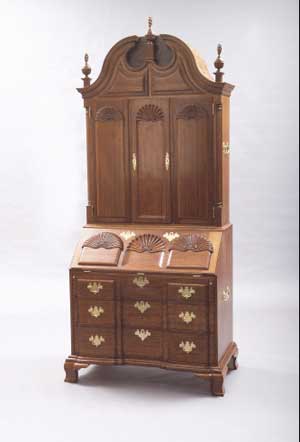
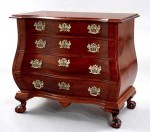 Tony Kubalak has liked the style of 18th century furniture ever since he saw a photo of a Newport shell in the 1980s – but, for a long time, he didn’t think he’d ever be able to make any.
Tony Kubalak has liked the style of 18th century furniture ever since he saw a photo of a Newport shell in the 1980s – but, for a long time, he didn’t think he’d ever be able to make any.
Tony started dabbling in woodworking in the 1970s, “but I resigned myself never to be able to do fancy stuff. I didn’t know how to carve. I thought you had to be an artist,” he said.
For example, he said, he built a Queen Anne table with cabriole legs, but it didn’t have any carving on it: “just the shapes.”
In 1999, however, Tony found out about classes offered by Gene Landon. “That’s when the 18th century stuff took off,” Tony said. “Working with Gene, I learned how things were put together. 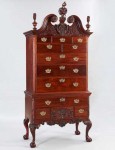 What at first seemed impossible gets broken down into steps and becomes manageable and learnable.”
What at first seemed impossible gets broken down into steps and becomes manageable and learnable.”
One of the clues to learning how to make those 18th century pieces comes from the tool marks. “I learned from Gene that the original objects will have tool marks, and if you learn how to read them, you can tell how the piece was made,” said Tony. That’s why, in his own work, in contrast to other types of woodworking, “It’s a different approach. You’re not sanding off every tool mark. In a reproduction, leaving the correct tool marks in the correct spot is actually desirable.”
 What tools are making those marks? For the most part, Tony said, it’s carving chisels, hand planes, files and rasps. “I don’t not use a power tool ever” – for instance, he uses them for roughing out wood – “it’s just that a lot of the stuff I do, a power tool isn’t very helpful. With the carvings, I have no idea how you’d do it with a power tool.”
What tools are making those marks? For the most part, Tony said, it’s carving chisels, hand planes, files and rasps. “I don’t not use a power tool ever” – for instance, he uses them for roughing out wood – “it’s just that a lot of the stuff I do, a power tool isn’t very helpful. With the carvings, I have no idea how you’d do it with a power tool.”
And, in terms of 18th century style, “It’s the carvings that really attract me,” Tony said. “The forms and shapes, visually it’s appealing, but it’s the carvings that take what would have been a nice piece and make it great. What’s appealing to me is how ornate they are.”
When it comes to making the pieces, “coupled with the visual appeal is the challenge of ‘how do you do that?’ That’s part of the allure. Learning how things fit together to make an object is interesting to me.”
Tony is a software engineer by training and by employment, “but I’ve been told that’s really a detriment in this case sometimes. My instructor could look at a piece and see how to do it; I’d have to think about it more.”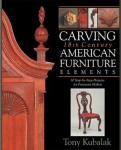
It was partly due to that background that Tony came to write the book Carving 18th Century Furniture Elements (Linden Publishing, ISBN 978-1-933502-32-8). “I tried to add some engineering to the art, and take an analytical approach with a critical eye,” he said. “One of my goals was to help people interested in this have a source where they could at least try this stuff. When I first started, it was difficult to impossible finding someone to learn from. I hadn’t found Gene, I would never have the pieces on my website. He opened a world to me I didn’t even know about.”
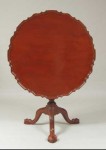 “My goal,” Tony said, “is to make a piece as close to the original as possible.” That might mean requesting extra access to a museum piece in order to take measurements. Or, it might mean studying the photos in an auction catalog “Auction catalogs are a fabulous resource to look at the pictures,” he said. “You develop your eye as to not only what looks good, but also how to make them. When the best you have to work from is usually a picture, you’ve got to be able to look at a picture.”
“My goal,” Tony said, “is to make a piece as close to the original as possible.” That might mean requesting extra access to a museum piece in order to take measurements. Or, it might mean studying the photos in an auction catalog “Auction catalogs are a fabulous resource to look at the pictures,” he said. “You develop your eye as to not only what looks good, but also how to make them. When the best you have to work from is usually a picture, you’ve got to be able to look at a picture.”
Since the pieces which most interest Tony were typically done in mahogany or walnut, that’s what he most often uses as primary woods. Secondary woods are poplar or pine, “depending on what I can get.”
Tony estimates he’s made about 15 to 20 18th century style pieces, most of which reside in his 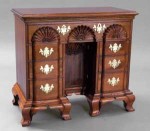 own home. During a few years when he was laid off out of the software engineering industry, he tried to make a business out of the period furniture, but “it was a good thing my wife had a job,” he said.
own home. During a few years when he was laid off out of the software engineering industry, he tried to make a business out of the period furniture, but “it was a good thing my wife had a job,” he said.
Overall, though, “I’m perfectly content to do this as an amateur,” he said. “I really like the mix of doing this with being a software engineer. One is working with your hands all the time, and the other you don’t do anything with your hands other than type keys on the keyboard. That’s a good mix for me.”





